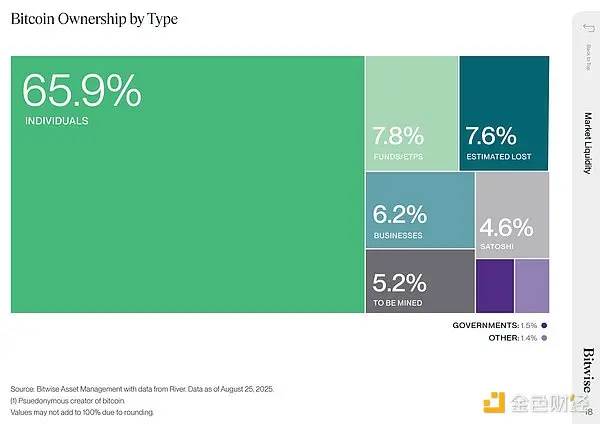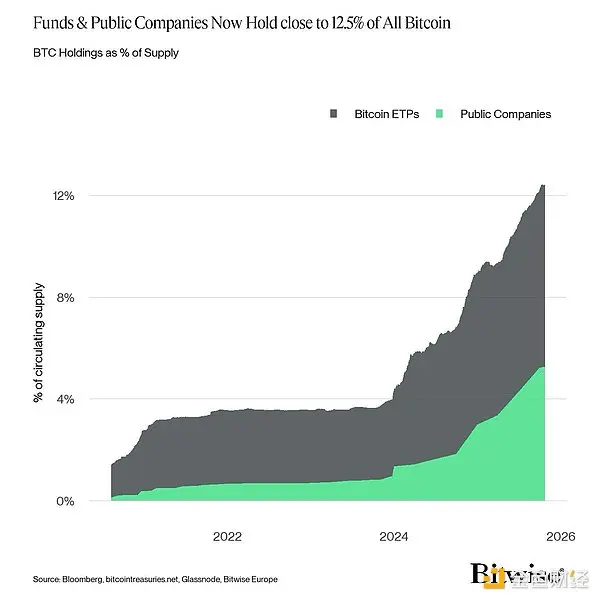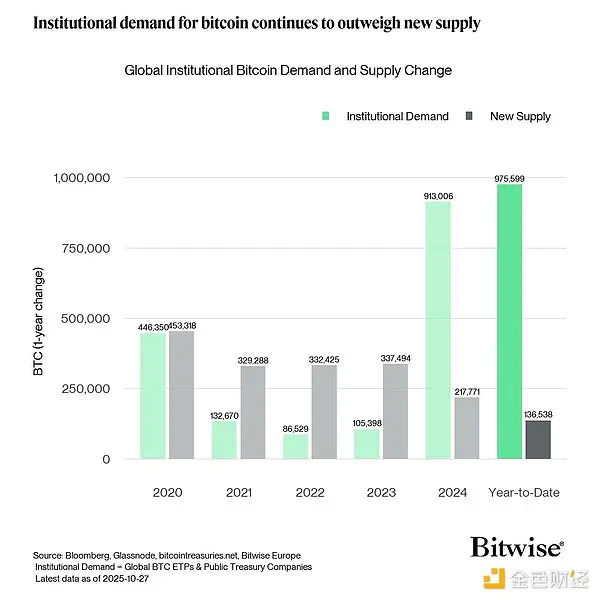Author: André Dragosch, Head of Research, Bitwise Europe; Translator: xiaozou (Jinse Finance)
If you have any doubts, please observe over a longer time frame.
This is the key chart essence of our latest Bitwise Quarterly Market Report.

This data clearly reveals the current general trend and can even explain the particularity of this Bitcoin cycle (data provided by River).
1. Understanding the essence of the "great transfer of wealth"
The key point is that Bitcoin is flowing from early retail investors to institutional investors (funds/exchange-traded products), businesses, and even government entities.
Unlike other traditional asset classes in history, Bitcoin's popularization path began with retail investors such as cypherpunks and early participants, before institutional investors such as family offices, fund managers, and ETFs made their first moves.
Even now, retail investors still account for about 66%, meaning that the vast majority of Bitcoin is still controlled by non-institutional investors (see the matrix distribution in the above figure)! In contrast, the latest data from the US 13F filings shows that institutional investors have a significantly higher allocation ratio in traditional asset classes.
Observe the institutional holdings of mainstream traditional financial ETFs:
- Institutional holdings account for 79% of the iShares 20+ Year Treasury Bond ETF (TLT).
- Institutional holdings account for 58% of the SPDR S&P 500 ETF (SPY);
- Institutional holdings account for 36% of SPDR Gold ETF (GLD).
According to the latest Bank of America Global Fund Managers Survey, the current average allocation to crypto assets (including Bitcoin and other tokens) is only 0.4%. (Note: Institutional holdings in IBIT are currently only 26%...)
This shows that, as the industry often says, "we are still in the early stages," and institutional adoption is still in its infancy.
However, it is undeniable that a large-scale wealth transfer is underway from retail investors to institutional investors. This migration of wealth from early retail holders to institutional investors will have multiple impacts, the far-reaching effects of which may exceed expectations:
2. Bitcoin Popularization: Trends and Cyclical Patterns
(1) Trend
First, let's be clear: this shift will not happen overnight, but rather is a long-term trend.
The reality is that the majority of Bitcoin is illiquid and held for the long term. Only about 14.5% of the Bitcoin supply is held in relatively liquid form on exchanges like Coinbase or Binance, while the rest remains illiquid in off-chain wallets.
Without economic incentives, Bitcoin wealth will not automatically transfer.
Many early holders set psychological price levels (such as $1 million/BTC) or economic goals (such as "funds for a house") as triggers to sell their Bitcoin, which are far above the current market price of approximately $115,000. For these illiquid tokens to enter the market (i.e., exchanges), the price of Bitcoin would need to rise significantly.
In this process, Bitcoin's reach will expand as ETFs hold assets for millions of individual investors in trust form. Publicly traded company financial reports also show that Bitcoin is held by hundreds of thousands of different investors. As of this writing, institutional investors (ETPs and publicly traded companies) control approximately 12.5% of the Bitcoin supply—and this figure is rapidly increasing.

(2) Periodicity
Most analysts would likely agree that early Bitcoin bull and bear cycles were primarily driven by halving events that occurred every 210,000 blocks (approximately 4 years), a mechanism that halved the amount of Bitcoin produced (hence the term "halving").
However, the impact of each halving event is diminishing with each subsequent event—both in absolute terms and as a percentage of the circulating supply. With increased institutional adoption and changes in demand structure, the halving effect has significantly weakened.
Data from 2025 shows that institutional demand has reached approximately seven times the supply gap caused by a halving!

In this process, the influence of traditional macroeconomic cycles has relatively increased—Bitcoin has become a true "macroeconomic asset".
Our quantitative analysis also shows that over 80% of Bitcoin price fluctuations in the past six months have been driven by macroeconomic factors such as global growth expectations and monetary policy, while token-specific factors have had less than 5% of the impact.
However, the dominance of macroeconomic factors also means that future Bitcoin bull and bear cycles will fluctuate in sync with macroeconomic/business cycles, and the four-year cycle driven by "halving" is likely to "fail".
This ultimately suggests that the accumulation and distribution of Bitcoin will depend on the dominant macroeconomic environment (expansion/prosperity vs. contraction/recession), thus triggering short-term price fluctuations in a risk-preference/risk-aversion pattern.
3. Conclusion
The fundamental meaning of the "great transfer of wealth" is that the price of Bitcoin needs to reach a higher level—far higher than it is now—in order to incentivize further adoption and complete the transfer from early retail investors to institutional investors.
The continued influx of institutional investors means that Bitcoin has become a true "macro asset," indicating that future bull and bear cycles will be increasingly dominated by macro/business cycles (rather than halving events).







